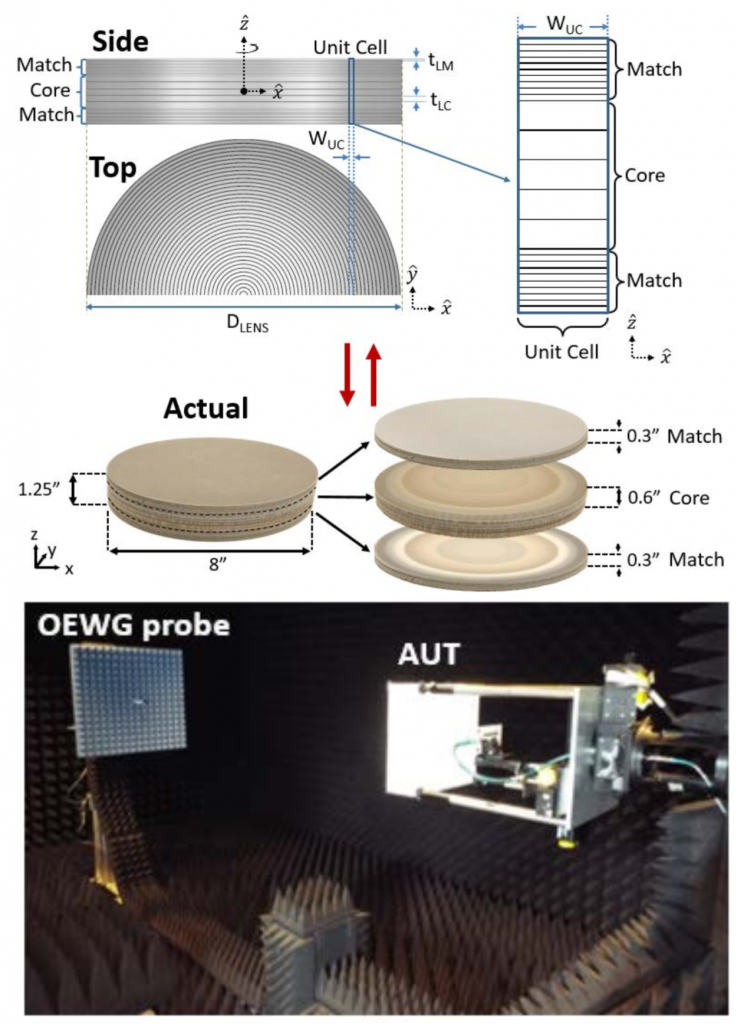Nicholas Garcia, working with Professor Chisum publishes article in IEEE TAP
June 18, 2020Professor Chisum and his graduate research assistant, Nicolas Garcia, have developed a method for the automated design of low-power, wideband, and high-efficiency millimeter-wave lens antennas operating from 8 GHz to well beyond 40 GHz (simulated up to 75 GHz). The published manuscript is in IEEE Transactions on Antennas and Propagation on April 30, 2020, entitled “High-efficiency, Wideband GRIN Lenses with Intrinsically Matched Unit-cells”.
This work was funded in part by industry partners (Parry Labs), the Office of Naval Research, and the National Science Foundation. The novel approach to gradient-index (GRIN) lens design is based upon an intrinsically matched unit-cell which ensures high aperture efficiency across extremely wide bandwidths and over both polarizations. The demonstrated lens antenna achieved aperture efficiency ranging from 31% to 72% (measured) from 12-40 GHz with projected performance from 25% to 86% (simulated) from 8-75 GHz.
The single demonstrated lens antenna can be used for a wide array of applications including:
- High-power (>5 MW EIRP) X-band radar
- Wideband electronic warfare (both sensing and attack)
- Point-to-point backhaul communications (beamwidths on the order of 2 degrees with low-power switch-beam electronic scanning possible)
- Low-power and low-cost 5G millimeter-wave small cell access points
- WiGig and related in-home connectivity
- Future millimeter-wave bands for 5G and 6G (76/86 GHz)
- Millimeter-wave last-mile services for home internet (replacing fiber)
- Satellite on-the-move communications (in-flight connectivity)
- End-user antennas/modems for space-based internet via Ka-band mega-constellations like Starlink, Project Kuiper and OneWeb.
- Ongoing research is working to extend the frequency of operation even further into the millimeter-wave regime to support emerging MMW communications applications at 76/86 GHz, 120 GHz, 180 GHz, 190 GHz.
Abstract: We present an automated design procedure for the rapid realization of wideband millimeter-wave lens antennas. The design method is based upon the creation of a library of matched unit-cells which comprise wideband impedance matching sections on either side of a phase-delaying core section. The phase accumulation and impedance match of each unit-cell is characterized over frequency and incident angle. The lens is divided into rings, each of which is assigned an optimal unit-cell based on incident angle and required local phase correction given that the lens must collimate the incident wavefront. A unit-cell library for a given realizable permittivity range, lens thickness, and unit-cell stack-up can be used to design a wide variety of flat wideband lenses for various diameters, feed elements, and focal distances. A demonstration GRIN lens antenna is designed, fabricated, and measured in both far-field and near-field chambers. The antenna functions as intended from 14GHz to 40GHz and is therefore suitable for all proposed 5G MMW bands, Ku- and Ka-band fixed satellite services. The use of intrinsically matched unitcells results in aperture efficiency ranging from 31% to 72% over the 2.9:1 bandwidth which is the highest aperture efficiency demonstrated across such a wide operating band.
Link to the article: High-efficiency, Wideband GRIN Lenses with Intrinsically Matched Unit-cells


